Selected photographs from
The Southern
Diaspora: How the Great Migrations of Black and White Southerners Transformed
America
|
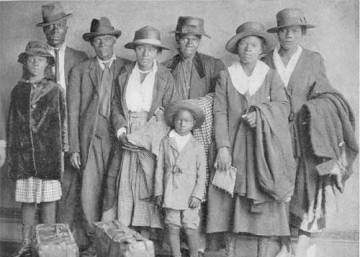
A southern family arriving in Chicago during World War I. (Chicago
Commission on Race Relations, The Negro in Chicago [Chicago, 1922]) |

Coming to work at River Rouge. Among the 96,000 employees at Henry Ford’s
Detroit plant by 1944 were 15,000 blacks and at least as many white
southerners. (Walter P. Reuther Library, Wayne State University) |
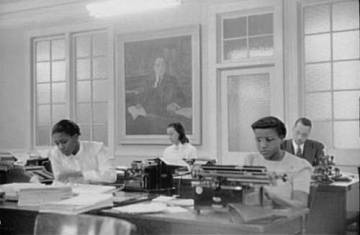
In 1940 when this picture was taken, blacks were excluded from most
clerical, sales, and white collar jobs. Firms that served the black
community, such as this Chicago-based insurance company, provided a handful
of opportunities for well educated migrants to use their skills. (Library of
Congress, Prints & Photographs Division, FSA-OWI Collection) |
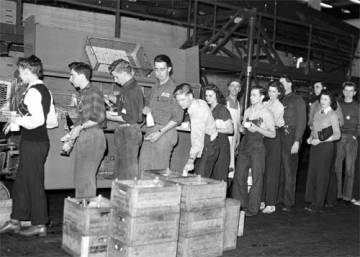
Henry Ford’s massive Willow Run B-24 bomber plant at Ypsilanti, Michigan,
hired thousands of southern migrants during World War II, mostly whites.
Ford had taken the lead in hiring black workers in the 1910s and 1920s, but
changed course in the early 1940s after black workers joined the United Auto
Workers union. (Walter
P. Reuther Library,
Wayne State University ) |

Posing in blackface for a Chicago Daily News feature in 1929, Freeman
Gosden (a white migrant from Virginia left) and Richard Correll
were the voices behind Amos ‘n’ Andy, the most popular program on
radio. The nightly radio skits helped change understandings of American
racial geography while disseminating powerful images of black southerners in
the big cities of the North. (Chicago Historical Society) |
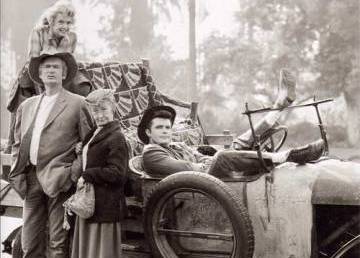
The most
popular show on television in the early 1960s, The Beverly Hillbillies
continued the tradition of hillbilly representations that had influenced
southern white identities since the 1920s. |
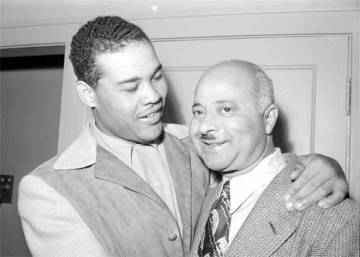
Boxing great Joe Louis with John Roxborough, the attorney/policy
king/businessman who, with his partner Julian Black, managed the fighter’s
career. Twelve years old when his family moved to Detroit from rural
Alabama, Louis broke boxing's color line using the institutional resources
of the Black Metropolis. (Walter
P. Reuther Library,,
Wayne State University) |
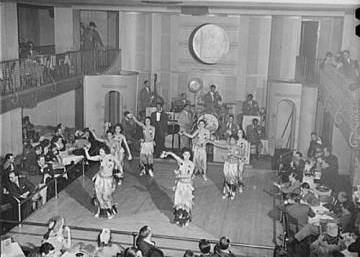
Part of black Chicago’s large entertainment zone, this cabaret catered to
well-heeled audiences, mostly whites on this evening in 1941. More than
1,000 musicians, actors, and dancers worked in Bronzeville's entertainment
sector. (Library of Congress, Prints & Photographs Division, FSA-OWI
Collection) |
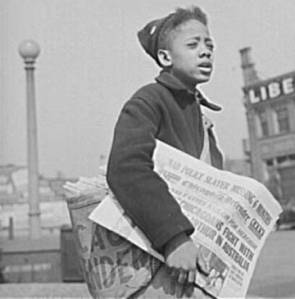
Selling the Chicago Defender, 1942. Newspapers keyed the new cultural
apparatus that southern migrants built in the great cities of the North.
(Library of Congress, Prints & Photographs Division, FSA-OWI Collection) |
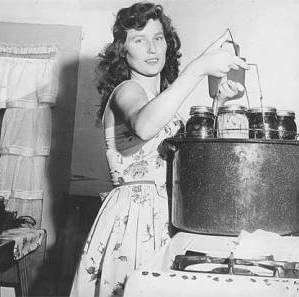
Lorretta
Lynn’s country music career began not in Kentucky but in northern Washington
State. Winner of 17 blue ribbons for canning at the Northwest Washington
State fair she poses for this 1958 newspaper photo. That was also the year
that she joined a local band and began singing in local clubs. (Bellingham
Herald) |
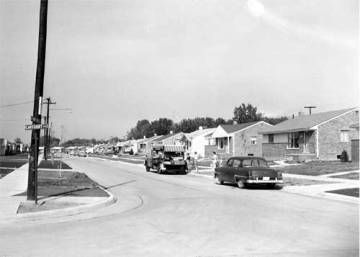
Warren, Michigan, 1956. This Detroit suburb and other suburbs across the
North and West were favored residential choices for white southern migrants.
(Walter P.
Reuther Library,, Wayne
State University) |
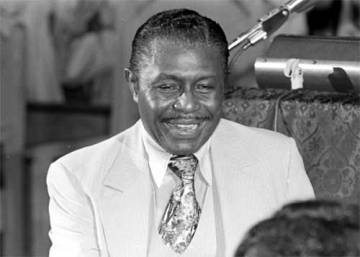
Reverend C.L. Franklin turned New Bethel Baptist into one of the largest and
most politically active black churches in Detroit. Father of Aretha
Franklin, C.L. grew up in rural Mississippi and held his first pastorate in
Memphis. The family moved to Detroit in 1944. (Walter
P. Reuther Library,
Wayne State University) |

Elder Lucy
Smith (here in 1941) led All Nations Pentecostal Church, Chicago’s largest
Pentecostal assembly. The dynamic faith healer migrated from Georgia in
1910. (Library of Congress, Prints & Photographs Division, FSA-OWI
Collection) |
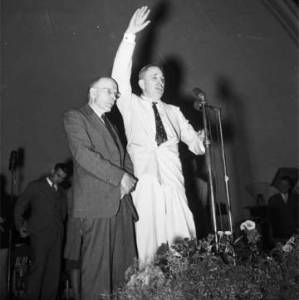
Reverend J. Frank Norris turned Detroit’s Temple Baptist into a bastion of
rightwing fundamentalism. Norris (right) joins Michigan Governor
Luren Dickinson, a prohibitionist, at a 1940 campaign rally. Norris commuted
between his churches in Detroit and Ft. Worth from 1935 to 1950. (Walter
P. Reuther Library,
Wayne State University) |
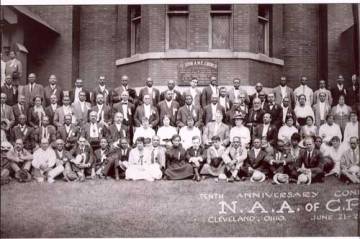
Some of the delegates to the 1919 convention of the NAACP held in Cleveland.
The bi-racial organization was an example of the new political alliances
that became possible in the Black Metropolises of the North. (Emma and Lloyd
Lewis Family Papers [LF neg. 14B] Special Collections Library. University of
Illinois at Chicago) |
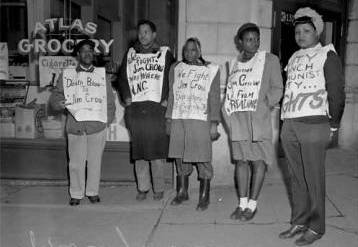
Picketers
in front of a Seattle grocery store, 1947. Supported by CIO unions, church
groups, Jewish organizations, and the Communist Party, black activists
forced most stores and restaurants to end “white only” service policies in
that city by the end of the 1940s. In 1949, the same coalition secured a
Fair Employment Practices Act for Washington State. (Museum of History and
Industry, Seattle, #13693) |
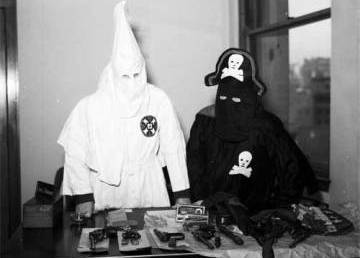
Detroit detectives show off confiscated robes, masks, and weapons belonging
to the Black Legion. Before the Klan-linked organization was broken up in
1936, members had committed a string of murders and assaults in Ohio,
Indiana, and Michigan. Newspaper reports claimed that most of the members
were former southerners. (Walter P. Reuther Library, Wayne State University) |

George Wallace enjoyed considerable support in the white suburbs and smaller
cities of Michigan. Note the “Vote for Wallace” t-shirt at this 1971
anti-busing demonstration in Pontiac Michigan. (Walter
P. Reuther Library,
Wayne State University) |
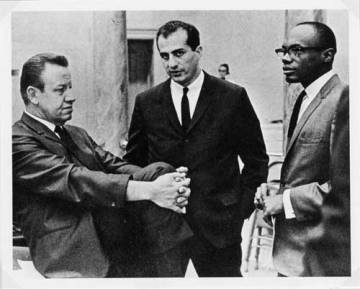
Former Texan Jesse Unruh (left) was Speaker of the California State Assembly
when this photo was taken in 1966. With him is Robert Moretti (born in
Detroit) who would become Speaker in 1971, and fellow Texan Willie Brown ,
Speaker from 1980 to 1995. (James D. Richardson papers, Department of
Special Collections and University Archives, The Library, California State
University, Sacramento) |
|